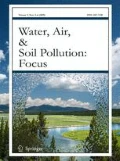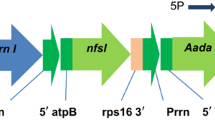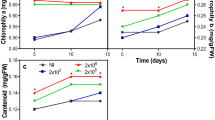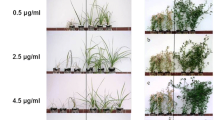Abstract
The manufacture and improper disposal of explosives has resulted in a significant amount of land requiring remediation. The compound 2,4,6-trinitrotoluene (TNT) is the most persistent and toxic of the explosive pollutants with current treatment methods being energy intensive and costly. Bacterial enzymes such as pentaerythritol tetranitrate reductase (PETNR) from Enterobacter cloacae PB2 have been found to have activity against TNT; however, microbes often lack the biomassnecessary for remediation applications. The PETNRgene (onr1) was transformed into tobacco plants in an attempt to combine the metabolic diversity of microbes with the sequestering properties of plants. The resulting transgenic plants were shown to have enhanced tolerance to TNT during germination and as seedlings. Phytoremediation applications with these plants may provide an alternative treatment of TNT contamination.
Similar content being viewed by others
References
Best, E. P., Zappi, M. E., Fredrickson, H. L., Sprecher, S. L., Larson, S. L. and Ochman, M.: 1997, 'Screening of aquatic and wetland plant species for phytoremediation of explosives-contaminated groundwater from the Iowa Army Ammunition Plant', Ann. N. Y. Acad. Sci. 829, 179-194.
Bhadra, R., Wayment, D. G., Hughes, J. B. and Shanks, J. V.: 1999, 'Confirmation of conjugation processes during TNT metabolism by axenic plant roots', Environ. Sci. Technol. 33, 446-452.
Binks, P. R., Nicklin, S. and Bruce, N. C.: 1995, 'Degradation of hexahydro -1,3,5 - trinitro - 1,3,5-triazine by Stenotrophomonas maltophilia PB1', Appl. Environ. Microbiol. 62, 1214-1219.
French, C. E., Nicklin, S. and Bruce, N. C.: 1996, 'Sequence and properties of pentaerythritol tetranitrate reductase from Enterobacter cloacae PB2', J. Bacteriol. 178, 6623-6627.
French, C. E., Nicklin, S. and Bruce, N. C.: 1998, 'Aerobic degradation of 2,4,6-trinitrotoluene by Enterobacter cloacae PB2 and by pentaerythritol tetranitrate reductase', Appl. Environ. Microbiol. 64, 2864-2868.
French, C. E., Rosser, S. J., Davies, G. J., Nicklin, S. and Bruce, N. C.: 1999, 'Biodegradation of explosives by transgenic plants expressing pentaerythritol tetranitrate reductase', Nat. Biotechnol. 17, 491-494.
Gleave, A. P.: 1992, 'A versatile binary vector system with a T-DNA organisational structure conducive to efficient integration of cloned DNA into the plant genome', Plant Mol. Biol. 20, 1203-1207.
Goel, A., Kumar, G., Payne, G. F. and Dube, S. K.: 1997, 'Plant cell biodegradation of a xenobiotic nitrate ester, nitroglycerin'. Nat. Biotechnol. 15, 174-177.
Hughes, J. B., Shanks, J., Vanderford, M., Lauritzen, J. and Bhadra, R.: 1997, 'Transformation of TNT by aquatic plants and plant tissue cultures', Environ. Sci. Technol. 31, 266-271.
Pavlostathis, S. G., Comstock, K., Jacobson, M. E. and Saunders, F. M.: 'Transformation of 2,4,6-trinitrotoluene by the aquatic plant Myriophyllum spicatum', Environ. Tox. Chem. 17, 2266-2273.
Author information
Authors and Affiliations
Corresponding author
Rights and permissions
About this article
Cite this article
Hannink, N.K., Rosser, S.J., French, C.E. et al. Uptake and Metabolism of TNT and GTN by Plants Expressing Bacterial Pentaerythritol Tetranitrate Reductase. Water, Air, & Soil Pollution: Focus 3, 251–258 (2003). https://doi.org/10.1023/A:1023906523833
Issue Date:
DOI: https://doi.org/10.1023/A:1023906523833




